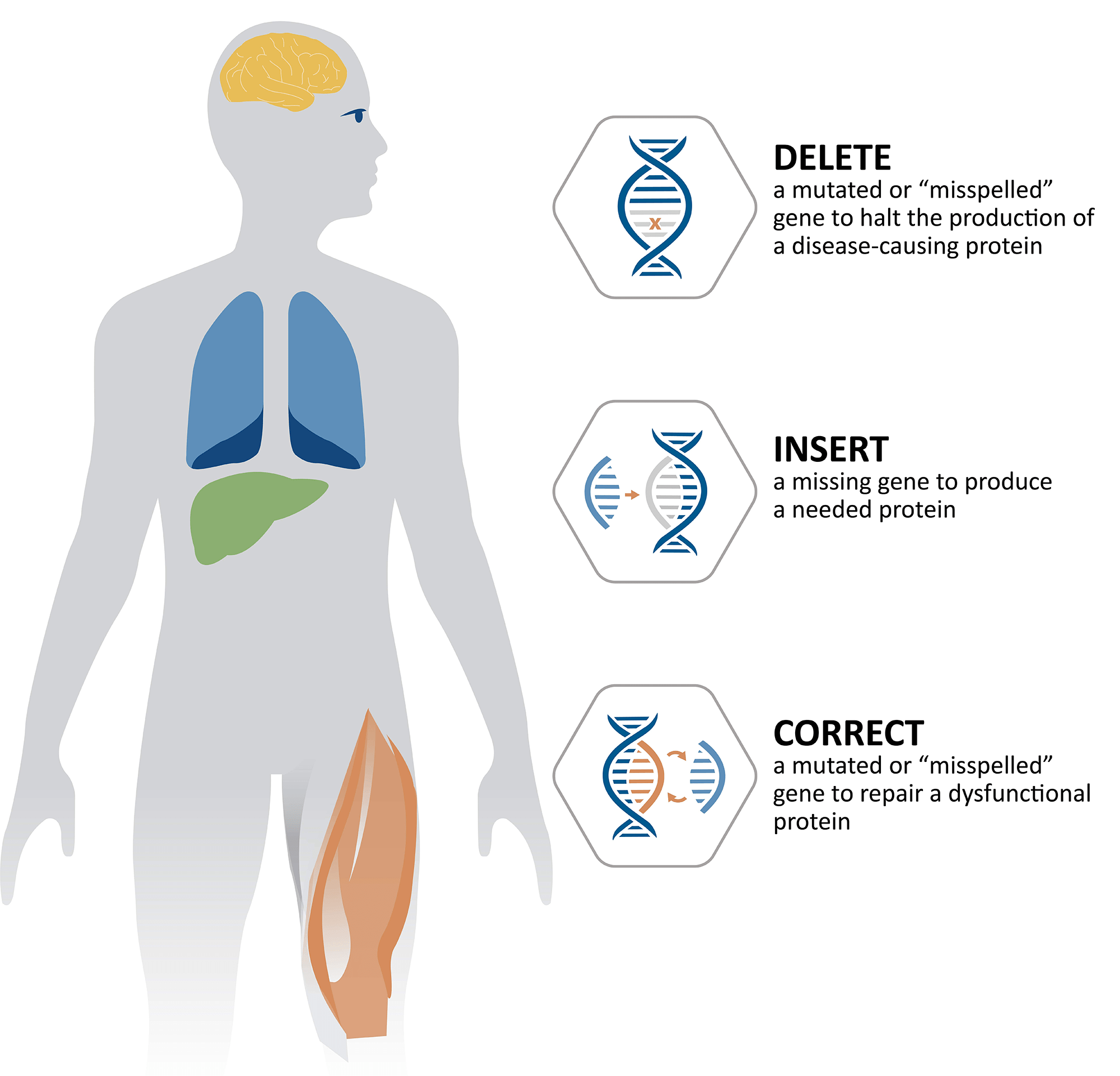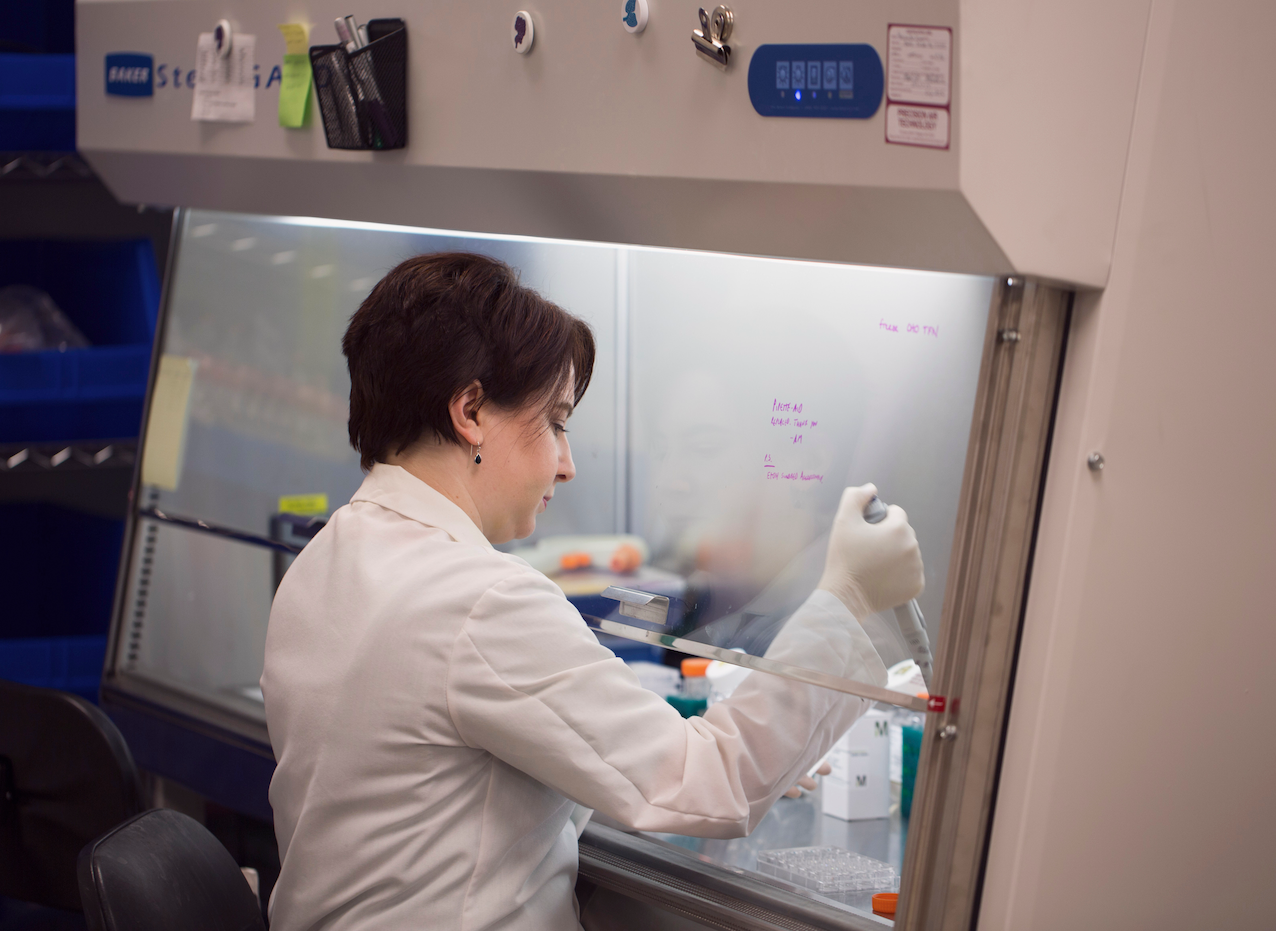Gene editing with ARCUS has the potential to deliver one-and-done treatments for genetic diseases.
In vivo gene editing has the potential to permanently cure genetic diseases. Unlike some editing technologies that have been designed as research tools and subsequently engineered for therapeutic use, ARCUS is a precise and versatile genome editing technology with the distinct potential to insert, delete, or repair disease-causing DNA in a broad spectrum of genetic diseases.


Gene editing enzymes are large molecules that cannot disperse across the body like traditional small molecule drugs. This means that therapeutic genome editing is not a whole-body event, but one that targets specific cells and tissues where the gene that requires correction is active. It also means the therapeutic potential of any gene editing tool is tied to its ability to reach target cells and tissues and complete complex edits safely and efficiently.
Learn more about our preclinical in vivo gene editing pipeline ›
Scientific Publications and Presentations
Treatment with PBGENE-DMD results in durable improvements in muscle function over time through increased dystrophin expression and dystrophin-positive cells
Mischler, Adam. et al. (2025) World Muscle Society
High-efficiency homology-directed insertion into the genome using the engineered homing endonuclease ARCUS
Martin, Aaron, et. al. (2025) Nucleic Acids Research, Vol 53, Issue 18.
ARCUS-Mediated Excision of Exons 45-55 of the Human Dystrophin Gene using PBGENE-DMD Leads to Durable Muscle Function Improvements In Vivo as a Result of Functional Dystrophin Protein Restoration for the Treatment of Duchenne Muscular Dystrophy
Mischler, Adam, et. al. (2025) American Society of Gene & Cell Therapy.
Excision of the C9orf72 Hexanucleotide Repeat Expansion Using a Dual-ARCUS Gene Editing Approach Delivered by a Single AAV Reduces Neurotoxic RNA Foci and Dipeptides in an In Vivo Model of ALS
McKinstry, Spencer, et. al. (2025) American Society of Gene & Cell Therapy
Initial safety data from ELIMINATE-B, the first clinical trial of a gene editing treatment for chronic hepatitis B.
Jucov, Alina, et al. (2025) The European Study of the Association of the Liver Conference.
High-efficiency homology-directed insertion into the genome using ARCUS nucleases.
Mischler, A., et al. European Society of Gene & Cell Therapy (ESGCT) 2024 Annual Congress.
Preclinical safety data for PBGENE-HBV gene editing program supports advancement to clinical trials as a potentially curative treatment for chronic hepatitis B
Harrison, E. et al. European Association for the Study of the Liver (EASL) Congress 2024.
Optimization of targeted gene insertion using ARCUS nucleases
Shoop W, et al., Precision Genome Engineering 2023 Conference
Specific elimination of m.3243A>G mutant mitochondrial DNA using mitoARCUS
Shoop W., et al., EuroMIT Conference 2023 Conference
Shifting m.3243A>G heteroplasmy with PBGENE-PMM: Gene editing therapy for primary mitochondrial myopathy
Shoop W, et al., Mitochondrial Medicine – Therapeutic Development 2024 Conference
ARCUS-mediated excision of the “hot spot” region of the human dystrophin gene results in functional improvement in a mouse model of Duchenne muscular dystrophy (DMD)
Owens, G., et al. European Society of Gene and Cell Therapy (ESGCT) 2023 Annual Congress.
Unique features of ARCUS nucleases enable high efficiency, targeted gene insertion in vivo
Gorsuch, C., et al. European Society of Gene and Cell Therapy (ESGCT) 2023 Annual Congress.
Efficient elimination of MELAS-associated m.3243G mutant mitochondrial DNA by an engineered mitoARCUS nuclease
Shoop, W.K., Lape, J., Trum, M. et al. Efficient elimination of MELAS-associated m.3243G mutant mitochondrial DNA by an engineered mitoARCUS nuclease. Nat Metab (2023). https://doi.org/10.1038/s42255-023-00932-6
Preclinical efficacy and safety of ARCUS-POL nucleases for chronic hepatitis B: a potentially curative strategy
Harrison E., et al. American Association for the Study of Liver Diseases (AASLD) The Liver Meeting 2023.
Precise and simultaneous quantification of mitochondrial DNA heteroplasmy and copy number by digital PCR
Shoop, W. K., Gorsuch, C. L., Bacman, S. R., Moreas, C. T. (2022) Journal of Biological Chemistry, 298(11). https://doi.org/10.1016/j.jbc.2022.102574
Treating Transthyretin Amyloidosis via Adeno-Associated Virus Vector Delivery of Meganucleases
Greig, J. A., Breton, C., Ashley, S. N., (2022) Human Gene Therapy. 33(21-22). 1174-1186. http://doi.org/10.1089/hum.2022.061
ARCUS gene editing of Apolipoprotein C3 results in substantial reduction in serum triglycerides in vivo
Shoop W., et al. European Society of Gene & Cell Therapy (ESGCT) 2022 Annual Congress.
Specific elimination of m.3243A>G mutant mitochondrial DNA using mitoARCUS in cultured cells and a novel xenograft mouse model
Shoop, W., European Society of Gene & Cell Therapy (ESGCT) 2022 Congress.
Targeting the Hepatitis B cccDNA with a Sequence-Specific ARCUS Nuclease to Eliminate Hepatitis B Virus In Vivo
Nemec P., et al. International HBV Meeting 2022.
ARCUS Gene Editing to Eliminate MELAS-Associated m.3243A>G Mutant Mitochondrial DNA
Shoop W., et al. American Society of Gene and Cell Therapy (ASGCT) 2022 Annual Meeting.
Optimization of Hydroxyacidoxidase 1 (HAO1) Targeting ARCUS Nucleases for the Treatment of Primary Hyperoxaluria Type 1 (PH1)
Owens G., et al. American Society of Gene and Cell Therapy (ASGCT) 2022 Annual Meeting.
Targeting the Hepatitis B cccDNA with a Sequence-Specific ARCUS Nuclease to Eliminate Hepatitis B Virus In Vivo
Gorsuch C. L., Nemec, P., Yu, M., (2022) Molecular Therapy. 30(9), 2909-2022. https://doi.org/10.1016/j.ymthe.2022.05.013
Targeting the Hepatitis B cccDNA with a Sequence-Specific ARCUS Nuclease to Eliminate Hepatitis B Virus In Vivo
Gorsuch, C. et al. HEP DART 2021 Annual Conference.
Mitochondrial Targeted Meganuclease as a Platform to Eliminate Mutant mtDNA In Vivo
Zekonyte, U. Bacman, S. R., Smith, J. (2021) Nature Communications. 12, 3210. https://doi.org/10.1038/s41467-021-23561-7
Rho 1-2 Meganuclease, an Allele-Specific Gene Editing Therapy, Rejuvenates Rod Photoreceptor Structure and Function in a Pig Model of adRP
Jalligampala, A. et al. Association for Research in Vision & Ophthalmology (ARVO) 2021 Meeting.
Translation of an AAV-Delivered Gene Editing Approach for Transthyretin Amyloidosis in Animal Models
Greig, J.A. et al. American Society of Gene and Cell Therapy (ASGCT) 2021 Annual Meeting.
Long-Term Stable Reduction of Low-Density Lipoprotein in Nonhuman Primates Following In Vivo Genome Editing of PCSK9
Wang, L., Breton, C., Warzecha, C. C., (2021) Molecular Therapy. 6, 2019-2029. https://doi.org/10.1016/j.ymthe.2021.02.020
Meganuclease Targeting of PCSK9 in Macaque Liver Leads to Stable Reduction in Serum Cholesterol
Wang, L., Smith, J., Breton, C. (2018) Nature Biotechnology. 36, 717–725. https://doi.org/10.1038/nbt.4182
Engineering a Self-inactivating Adeno-associated Virus (AAV) Vector for ARCUS Nuclease Delivery
Li, H. et al. American Society of Gene and Cell Therapy (ASGCT) 2020 Annual Meeting.
A Gene Editing Approach to Eliminate Hepatitis B Virus Using ARCUS Meganucleases
Gorsuch, C. et al. American Society of Gene and Cell Therapy (ASGCT) 2020 Annual Meeting.

